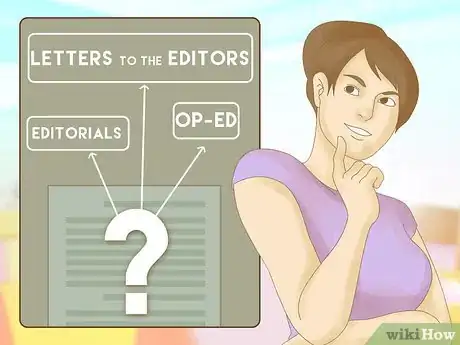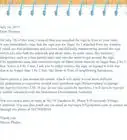This article was co-authored by Christopher Taylor, PhD. Christopher Taylor is an Adjunct Assistant Professor of English at Austin Community College in Texas. He received his PhD in English Literature and Medieval Studies from the University of Texas at Austin in 2014.
There are 8 references cited in this article, which can be found at the bottom of the page.
This article has been viewed 39,918 times.
Opinion pieces are an exciting and engaging part of most publications. They allow readers to have a voice on current events while also promoting ongoing discussion about those events. Whether you're new to writing or have a long record of submitting to publications, learning how to craft and submit your own opinion piece can help you get your byline featured in print and on the web.
Steps
Arranging Your Opinion Piece
-
1Format your opinion piece correctly. The basic format for most opinion pieces is to open with a lead paragraph, follow with supporting paragraphs, and end with a conclusion. Each paragraph should build off of the previous one and maintain the reader's interest through the entire piece.[1]
- The lead paragraph should hook a reader from the start. Many writers find that using a story or vivid example that relates to the main topic in the first sentence can help catch a reader's interest.
- The supporting paragraphs should build off of the introduction. You'll want to pepper your supporting paragraphs with facts, statistics, quotes (if any), and personal anecdotes to help strengthen your argument.
- The conclusion should be compelling, and it should leave readers feeling that they understand the subject and your viewpoint on it. Let your readers know what they can do to get involved in the cause you discuss, or frame your argument in a wider context by establishing why it matters and how it impacts the larger world.
-
2Write a byline and cover letter. Whether you pitch your idea or submit it blindly, you'll need to compose a short bio (called a byline in print media) in which you describe yourself, your location, and your credentials in 2-3 sentences. A byline should be written in the third person.[2] You should also write a professional cover letter that is addressed to the editor of that specific publication. Your cover letter doesn't need to be long, but it should describe your attached piece, explain why you think it should be published, and thank the editor for his or her time.
- A byline might read something like, "John Doe is an environmental activist working for _____. He's working closely with the EPA on the ongoing excavation and visits the site on a daily basis to conduct soil tests in the region."
Advertisement -
3Submit your piece. Once you've written your piece and the accompanying byline and cover letter, you're ready to submit it to a publication. You can submit your piece directly to the editor by using the email address provided on a given publication's website. Don't forget to include your contact information, including your name, your daytime phone number, and some title or affiliation that clarifies your authority on the subject.[3]
- Decide whether to pitch the idea or submit it unsolicited. There is no "right" way of submitting; some writers will email an editor at the start of the day and pitch their idea for an opinion piece, while others simply submit blindly.
-
4Follow up with the editor. Some editors say that if you don't hear a response within 48 hours there's a good chance your piece isn't being picked up, but once in a while submissions get held up for various reasons.[4] Sometimes there are technical errors that prevent the editor from getting your submission, which you wouldn't know about without following up. Other times the editor may like the piece and decide to wait for a better issue to include it in. For example, one New York Times editor has held opinion pieces for up to two years before printing them.[5]
- Send a polite and professional email if you haven't heard anything after 48 hours.
- You should also ask the editor about the possibility of getting paid for your writing once it's been accepted, as many editors will give a paycheck only if asked about it.
Making Sure Your Opinion Piece Gets Noticed
-
1Research a publication to know your potential audience. Every publication has a different angle they may wish to cover a story from. This angle is usually what draws readers to that particular publication. That may be true of both the political slant of that publication and the general subjects that are usually addressed by the editors and contributors. You won't get a liberal-leaning piece published in a conservative newspaper, or vice versa, so know your audience before you submit anything.[6]
- Check the general angle of both the publication you're considering and its typical audience.
- If you read a publication regularly, you should be familiar with that publication's opinions and beliefs.
- If you're not familiar with the publication, you can search online to familiarize yourself with their style and their political leanings.
- Don't forget that you'll need to write for a general audience. That means using easily-understood (but not poorly-written) language without any technical terms or jargon.[7]
-
2Acknowledge dissenting viewpoints. Even if you're pitching an opinion piece to a publication whose readership agrees with you, a good editor will look for some acknowledgement of the opposition. It's easy to write a long-winded rant about a subject, but a strongly-written opinion piece should analyze the issue from all angles while still promoting the author's personal beliefs.[8]
- Identify the dissenting viewpoint and its most prominent advocates early on in the piece. Acknowledge the strongest arguments made by the opposition, rather than the weakest ones.
- Concede that the dissenting viewpoint has at least some valid points. This will help you come across as being more rational, and readers will be willing to stick with you.
-
3Make a logical and structured argument. Readers are more likely to be on board with an opinion piece that makes a logical and well-structured argument than a rambling or incoherent one. Make sure your ideas are clear and well-informed, and organize your ideas within the article so they flow in a coherent manner from one to the next.[9]
- Clearly outline your own argument, making sure to address the specific points that you will use in defense of your stance.
- Dismantle the logic behind the opposition's arguments, and support your stance using facts, statistics, and direct quotes from prominent figures working closely on that issue.
- Defend your argument with facts that cannot be debated. Work your argument's defense throughout the piece, beginning with a strong argument and building towards your strongest one.
-
4Focus on your link to the subject. Most editors will only publish an op-ed piece if the writer has a personal link to the subject being written about. That doesn't necessarily mean you need an advanced degree on that subject, but it does require some type of personal connection to the topic you're discussing.[10]
- One good rule of thumb is called the 80/20 rule. This rule states that your writing should be about 80% new or reinterpreted information regarding your topic, and 20% opinion and personal connection.
- Everyone has an opinion, so think about why anyone should have a vested interest in yours. You don't need to be an expert on your subject, but it should be relevant to your life.
- For example, most people have some opinion on war, but unless you're a veteran or have lost a relative in an ongoing war, your opinion probably won't stand out from most people's (and therefore may not be published).
-
5Disclose any personal connections. If you have a connection to an institution you're writing about, either through your own employment or through a close friend/relative's, be sure to disclose this clearly in your piece. If you don't, the editor might uncover this and see it as misleading or deceptive for you to withhold this information.
-
6Consider the timing for your piece. Before you sit down to write an opinion piece, you should consider how relevant that topic currently is. Has it been covered enough, or has it been over-covered in the news? You should also consider whether you have sufficient authority to discuss the subject. If not, you'll need to at least research the subject thoroughly and read the existing news and opinion pieces out there on that topic.[11]
Drafting a Strong Opinion Piece
-
1Decide on a format for your piece. There are many different types of opinion pieces. Generally speaking, if you are a reader submitting to a publication (and not a staff member of that publication) you will most likely submit either a letter to the editor or an op-ed piece.[12]
- Editorials - these are written by staff members at the newspaper. Unless you are a staff member, you probably will not be able to publish an editorial.
- Letters to the editor - these relatively short pieces generally address current events and news topics. They are heavily opinionated, yet focus on specific events.
- Op-ed (opposite the editorial page) pieces - these slightly longer pieces must be well-structured, well-researched, and they typically must display some type of expertise/credibility/advanced knowledge in a given field.
-
2Choose a topic. What you write about is entirely up to you, but if you want your piece to get published it needs to be relevant. Things currently in the news often make the best subjects, but any topic that is being hotly debated may be publishable, even if it isn't widely covered in the news.[13]
- Anything that has become a prevalent media topic or breeds controversy will make an excellent subject.
- If you get worked up thinking about the subject in one way or another, it's probably a good starting point for an opinion piece.
-
3Organize your thoughts. Decide on a central thesis or argument for your opinion piece. You should already know how you feel on the subject, so take it a step farther: why should other people agree with you? Take a firm stance and amp up your opinions on the piece, and be sure you write down all your thoughts to more easily keep track of them.[14]
- A highly-opinionated piece is more likely to provoke discussion, which means it's more likely to get published.
- Find and incorporate facts and details about the subject that others may not know. This can give you an edge over other people writing about the same subject.
-
4Craft a striking, attention-grabbing first paragraph. The opening paragraph is usually what hooks a reader, so it's important to get it right before you submit your piece. If your opening doesn't grab the editor's attention, it almost certainly won't catch a reader's interest.
- The opening line or lines should be engaging and intriguing enough that a reader blindly skimming your piece will want to keep reading.[15]
- One way to grab a reader right from the start is to open with either powerful imagery or an argumentative stance on some aspect of the subject you're writing about.
- A good opening line for an opinion piece on a recent factory closure might be something like, "The CEO of _____ didn't feel his fingers and toes clench up in the cold like we did as we walked out of our job for the last time this week."
-
5Develop a logical structure and format. Your opinion piece should be easy to follow for most readers. This means that your opinions should be backed up with verifiable facts, and one thought should lead clearly into the next without any awkward gaps of logic or narrative.
- Someone reading your opinion piece should immediately understand why you arrived at the opinions you hold.
- It should also be easy to understand how your thought process moved the discussion from one point to each subsequent point without ever losing focus or clarity.
- Have a trusted friend read your piece to confirm that your writing is clear and makes sense without needing any explanation.
-
6Work within the prescribed length. If you submit a piece that's far too long or too short, it's not likely to be published. You should check the website for any publication you're considering to find out what (if any) limits or word length ranges they typically hold writers to. If that information isn't available online, try emailing the editor to find out.
- Most publications print opinion pieces that run between 500 and 800 words in length.
- Some publications run shorter or longer opinion pieces. For example, the New York Times takes articles anywhere from 400 to 1,200 words in length.[16]
Expert Q&A
-
QuestionWhat is included in an opinion piece?
 Christopher Taylor, PhDChristopher Taylor is an Adjunct Assistant Professor of English at Austin Community College in Texas. He received his PhD in English Literature and Medieval Studies from the University of Texas at Austin in 2014.
Christopher Taylor, PhDChristopher Taylor is an Adjunct Assistant Professor of English at Austin Community College in Texas. He received his PhD in English Literature and Medieval Studies from the University of Texas at Austin in 2014.
English Professor Try beginning your piece with a pithy summary of your basic stance. Keep in mind that opinion essays are often written in an informal tone.
Try beginning your piece with a pithy summary of your basic stance. Keep in mind that opinion essays are often written in an informal tone. -
QuestionHow do I start writing for a magazine?
 Christopher Taylor, PhDChristopher Taylor is an Adjunct Assistant Professor of English at Austin Community College in Texas. He received his PhD in English Literature and Medieval Studies from the University of Texas at Austin in 2014.
Christopher Taylor, PhDChristopher Taylor is an Adjunct Assistant Professor of English at Austin Community College in Texas. He received his PhD in English Literature and Medieval Studies from the University of Texas at Austin in 2014.
English Professor If you're an aspiring writer, writing for magazines can be a great way to break into getting published. After selecting a topic, research magazines that might be a good fit, write a query letter to those magazines, and make sure to follow up with them once they respond.
If you're an aspiring writer, writing for magazines can be a great way to break into getting published. After selecting a topic, research magazines that might be a good fit, write a query letter to those magazines, and make sure to follow up with them once they respond. -
QuestionWhat is an opinion piece in journalism?
 Christopher Taylor, PhDChristopher Taylor is an Adjunct Assistant Professor of English at Austin Community College in Texas. He received his PhD in English Literature and Medieval Studies from the University of Texas at Austin in 2014.
Christopher Taylor, PhDChristopher Taylor is an Adjunct Assistant Professor of English at Austin Community College in Texas. He received his PhD in English Literature and Medieval Studies from the University of Texas at Austin in 2014.
English Professor In journalism, an opinion piece, or "op-ed," comments on relevant events from the perspective of an expert in that field. It is traditionally published opposite of the editorial page.
In journalism, an opinion piece, or "op-ed," comments on relevant events from the perspective of an expert in that field. It is traditionally published opposite of the editorial page.
References
- ↑ http://www.smith.edu/collegerelations/news-office/op-ed-guidelines
- ↑ http://www.writersdigest.com/writing-articles/by-writing-goal/improve-my-writing/10-rules-for-writing-opinion-pieces
- ↑ http://www.smith.edu/collegerelations/news-office/op-ed-guidelines
- ↑ http://www.writersdigest.com/writing-articles/by-writing-goal/improve-my-writing/10-rules-for-writing-opinion-pieces
- ↑ http://www.politico.com/media/story/2012/05/secrets-of-the-times-op-ed-pages-revealed-000503
- ↑ http://www.writersdigest.com/writing-articles/by-writing-goal/improve-my-writing/10-rules-for-writing-opinion-pieces
- ↑ https://www.gse.upenn.edu/system/files/u225/Opinion%20Essay.pdf
- ↑ http://www.geneseo.edu/~bennett/EdWrite.htm
- ↑ https://www.nytimes.com/2017/08/25/opinion/tips-for-aspiring-op-ed-writers.html
- ↑ http://www.writersdigest.com/writing-articles/by-writing-goal/improve-my-writing/10-rules-for-writing-opinion-pieces
- ↑ www.earth.columbia.edu/sitefiles/file/pressroom/.../OpEdGuide.doc
- ↑ www.earth.columbia.edu/sitefiles/file/pressroom/.../OpEdGuide.doc
- ↑ https://www.gse.upenn.edu/system/files/u225/Opinion%20Essay.pdf
- ↑ https://www.gse.upenn.edu/system/files/u225/Opinion%20Essay.pdf
- ↑ https://www.gse.upenn.edu/system/files/u225/Opinion%20Essay.pdf
- ↑ http://www.nytimes.com/content/help/site/editorial/op-ed/op-ed.html











































































